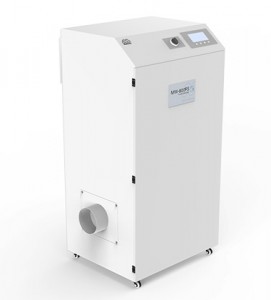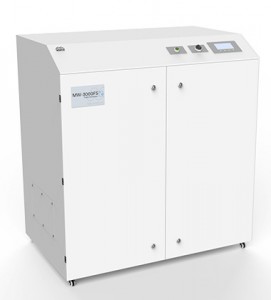Everything You Need to Know about Laser Fume Extractor, It's All Here!
Doing Research on Fume Extractors for Your CO2 Laser Cutting Machine?
Everything you need/ want/ should know about them, we have done the research for you!
So you don't have to do them yourself.
For your information, we have compiled everything into 5 main points.
Use the "Table of Content" Below for Quick Navigation.
What is a Fume Extractor?
A fume extractor is a specialized device designed to remove harmful fumes, smoke, and particles from the air, particularly in industrial settings.
When used with CO2 laser cutting machines, fume extractors play a crucial role in maintaining a safe and healthy work environment.
How does a Fume Extractor Work?
When a CO2 laser cutting machine operates, it generates heat that can vaporize the material being cut, producing hazardous fumes and smoke.
A fume extractor consists of several key components:
Fan System
This creates suction to draw in the contaminated air.
Then the air passes through filters that trap harmful particles, gases, and vapors.
Filtration System
The Pre-filters in the System Capture larger particles. Then HEPA Filters remove small particulate matter.
Finally Activated Carbon Filters will Absorb odors and volatile organic compounds (VOCs).
Exhaust
The cleaned air is then released back into the workspace or outside.
Plain & Simple.
Do you Need a Fume Extractor for Laser Cutting?
When operating a CO2 laser cutting machine, the question of whether a fume extractor is necessary is crucial for both safety and efficiency.
Here are compelling reasons why a fume extractor is essential in this context. (Because why not?)
1. Health and Safety
The primary reason for using a fume extractor is to protect the health and safety of workers.
During the laser cutting process, materials like wood, plastics, and metals can release harmful fumes and particles.
To name a few:
Such as formaldehyde from cutting certain woods.
Which can have short-term and long-term health effects.
Fine particles that can irritate the respiratory system.
Without proper extraction, these hazardous substances can accumulate in the air, leading to potential respiratory issues, skin irritation, and other health problems.
A fume extractor effectively captures and filters these harmful emissions, ensuring a safer working environment.
2. Quality of Work
Another critical factor is the impact on the quality of your work.
As a CO2 laser cuts through materials, smoke and particulates can obscure visibility and settle on the workpiece.
This can lead to Inconsistent cuts & Surface contamination, requiring additional cleaning & rework.
3. Equipment Longevity
Using a fume extractor not only protects workers and improves work quality but also contributes to the longevity of your laser-cutting equipment.
Smoke and debris can accumulate on the laser optics and components, leading to overheating and potential damage.
Regularly extracting these pollutants helps keep the machine clean.
Fume extractors minimize the need for frequent maintenance and cleaning, allowing for more consistent operation and less downtime.
Want to Know More about Fume Extractors?
Start Chatting with Us Today!
What Are the Differences Between Fume Extractors?
When it comes to fume extractors used in various applications,
especially for CO2 laser cutting machines,
it's important to understand that not all fume extractors are created equal.
Different types are designed to handle specific tasks and environments.
Here’s a breakdown of the key differences,
particularly focusing on industrial fume extractors for CO2 laser cutting
versus those used for hobbyist applications.
Industrial Fume Extractors
These are specifically engineered to handle fumes generated from materials like acrylic, wood, and certain plastics.
They are designed to capture and filter out a wide range of harmful particulates and gases that result from laser cutting, ensuring a clean and safe work environment.
These units often feature multi-stage filtration systems, including:
Pre-filters for larger particles.
HEPA filters for fine particulates.
Activated carbon filters to capture VOCs and odors.
This multi-layer approach ensures comprehensive air cleaning, suitable for the diverse range of materials cut by industrial lasers.
Designed to handle high airflow rates, these units can efficiently manage the large volumes of air produced during industrial laser cutting processes.
They ensure that the workspace remains well-ventilated and free of harmful fumes.
For Example, the Air Flow of the Machine we provided can range from 2685 m³/h to 11250 m³/h.
Built to withstand continuous operation in a demanding industrial environment, these units are typically more robust, featuring durable materials that can handle heavy usage without degrading.
Hobbyist Fume Extractors
Typically, these smaller units are meant for lower-volume operations and may not have the same filtration efficiency as industrial units.
They are designed for basic use with hobbyist-grade laser engravers or cutters,
which may produce less hazardous fumes but still require some level of extraction.
These may have basic filtration, often relying on simple charcoal or foam filters that are less effective at capturing fine particulates and harmful gases.
They are typically less robust and may require more frequent replacement or maintenance.
These units usually have lower airflow capacities, making them suitable for smaller projects but inadequate for high-volume industrial applications.
They may struggle to keep up with the demands of more extensive laser-cutting tasks.
Often made from lighter, less durable materials, these units are designed for intermittent use and may not be as reliable over time.
How to Choose One that Suits you?
Selecting the appropriate fume extractor for your CO2 laser cutting machine is crucial for ensuring a safe and efficient working environment.
We made a Checklist (Just for you!) so next time you can actively search for what you need in a Fume Extractor.
The airflow capacity of a fume extractor is vital.
It needs to effectively handle the volume of air generated during the laser cutting process.
Look for extractors with adjustable airflow settings that can accommodate the specific needs of your cutting operations.
Check the cubic feet per minute (CFM) rating of the extractor.
Higher CFM ratings indicate better ability to remove fumes quickly and efficiently.
Ensure that the extractor can maintain adequate airflow without causing excessive noise.
The effectiveness of the filtration system is another critical factor.
A high-quality fume extractor should have a multi-stage filtration system to capture a wide range of harmful emissions.
Look for models that include HEPA filters, which can trap 99.97% of particles as small as 0.3 microns.
This is essential for capturing fine particulates produced during laser cutting.
Activated Carbon Filters are also important for absorbing volatile organic compounds (VOCs) and odors,
particularly when cutting materials like plastics or wood that can release harmful fumes.
In many industrial settings, noise can be a significant concern, especially in smaller workspaces where multiple machines are in use.
Check the decibel (dB) rating of the fume extractor.
Models with lower dB ratings will produce less noise, creating a more comfortable working environment.
Look for extractors designed with noise-reduction features, such as insulated casings or quieter fan designs.
Depending on your workspace and production needs, the portability of the fume extractor may be an essential consideration.
Some fume extractors come with wheels that allow for easy movement between workstations.
This flexibility can be beneficial in dynamic environments where the setup may change frequently.
Regular maintenance is crucial for the effective operation of a fume extractor.
Choose models with easy access to filters for quick replacements.
Some extractors have indicators that signal when filters need changing, which can save time and ensure optimal performance.
Look for extractors that are easy to clean and maintain.
Models with removable parts or washable filters can reduce long-term operational costs.
Additional Information about Fume Extractor
Smaller Model of Fume Extractor for Machines Such as Flatbed Laser Cutter and Engraver 130
| Machine Size (mm) | 800*600*1600 |
| Filter Volume | 2 |
| Filter Size | 325*500 |
| Air Flow (m³/h) | 2685-3580 |
| Pressure (pa) | 800 |
Our Most Powerful Fume Extractor, and a Beast in Performance.
Designed for Flatbed Laser Cutter 130L & Flatbed Laser Cutter 160L.
| Machine Size (mm) | 1200*1000*2050 |
| Filter Volume | 6 |
| Filter Size | 325*600 |
| Air Flow (m³/h) | 9820-11250 |
| Pressure (pa) | 1300 |
Post time: Nov-07-2024



